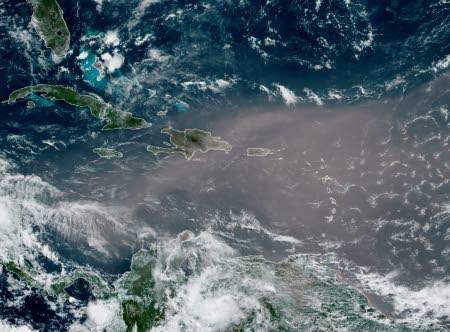THE dense plume of Saharan dust that shrouded much of the country yesterday is expected to peak today, with conditions worsening, though director of the country’s meteorological office Evan Thompson says there is no need for alarm.
“We’re expecting it [to continue] throughout this week. It should get worse tomorrow [today] and Wednesday and then it will start to dissipate. It’s something that happens every year [but] it’s just that it’s not always this thick, and it doesn’t always get as far west.
“But it does occur where you have these large areas of dust being lifted up by the wind and transported across the water. So, it’s just that in this case, it has been thicker and more extensive than it normally is, and so we’ll get more of an impact,” Thompson explained in a telephone interview with the Jamaica Observer yesterday.
The concentration of dust has been particularly high in recent days across the Caribbean region, with international media reporting that air quality across most of the region has fallen to “record hazardous levels”.
The Saharan dust is a mixture of sand and dust from the Sahara, a vast desert area that covers most of North Africa.
The Sahara, according to Encyclopaedia Britannica, is the largest desert in the world. Filling nearly all of northern Africa, it has a total area of some 3,320,000 square miles (8,600,000 square km). It is bordered in the west by the Atlantic Ocean, in the north by the Atlas Mountains and the Mediterranean Sea, in the east by the Red Sea, and in the south by the Sahel — a semi-arid region that forms a transitional zone between the Sahara to the north and the belt of humid savannas to the south.
The mass of extremely dry and dusty air, known as the Saharan Air Layer, forms over the Sahara Desert and moves across the North Atlantic every three to five days from late spring to early fall, peaking in late June to mid-August, according to the United States National Oceanic and Atmospheric Administration. It can occupy a roughly two-mile thick layer in the atmosphere, the agency noted.
Thompson said while the region has been impacted by the phenomenon “many times in the past”, it was difficult to explain why the blanket is thicker this time around.
The Associated Press has reported experts as saying it is the most significant event in the past 50 years, triggering dangerous conditions in many Caribbean islands.
“I don’t know what that reason is for it being thicker. It may just be that the conditions for this year might have been drier over the area of Africa’s coastline,” Thompson theorised yesterday.
At the same time, he said that there is no need for any great concern, though individuals with respiratory issues might be impacted.
“The main concern I think people have would be like for respiratory illnesses, because you have a lot more dust particles in the atmosphere. But, outside of that, there is no other threat. Temperatures could be warmer with less chance for rainfall. Those are some of the things we’ve been saying but it’s not like anything drastic,” he stated.
In a news release yesterday, the Ministry of Health and Wellness cautioned the public to guard against the effects of the Saharan dust.
It said excess exposure to the dust particles can have severe health effects, including increased risk of respiratory and related illness, such as asthma, chronic obstructive pulmonary disorder, and respiratory infection and allergies.
The ministry said skin and eye irritation can also be experienced, as there is an increased risk of waterborne illness.
The public, the health ministry said, and especially individuals who are already experiencing or are prone to respiratory illnesses, should exercise great care by observing the following precautions:
• Staying indoors as much as possible;
• Wearing face masks;
• Wearing long-sleeved clothing and protecting eyes;
• Washing hands regularly and avoid touching of eyes;
• Ensuring water that is harvested is treated; and
• Covering water used for domestic purposes, including drinking and food preparation.











